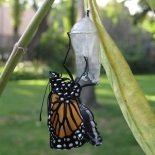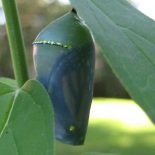|
Favorite Elementary School Science ProjectsRaising Monarch Butterflies
|
Below you will find an excellent and easy fall science project using plentiful common milkweed.
Also, there is a fun winter plant science project starting tropical milkweed from seed. This provides the caterpillar food for the spring science project raising monarch butterflies.
Each of these butterfly science projects has step by step instructions, tips and information to make these easy science projects successful.
Fall Butterfly Science Project
Fall is when the last batch of monarch butterflies emerge. These are the monarchs that migrate to Mexico.
As soon as school starts you can raise monarch butterflies. Make it your first fall elementary science project, especially in the Northern states, so that your Monarch butterflies can migrate safely before the weather gets too cold.
Monarch Caterpillar - Larvae
The first step is to order monarch caterpillars . You can either order one caterpillar for each student (upper grades possibly) or order several caterpillars to raise as a class.Butterfly Cage
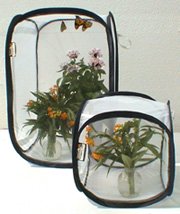
You will need a container to keep the caterpillars safe in the classroom. Here are some butterfly cages in various sizes....the jumbo “castle” is great if you are raising several caterpillars as a class....or make your own with plastic buckets. Make sure and sterilize all equipment (with bleach and water solution) if you are reusing it from year to year.
The caterpillars usually do not wander off until they are ready to pupate, so you might consider taking the caterpillars out of the cage during class so the students can get an up-close view of this miraculous process.
Milkweed – Monarch Food
There is usually an abundance of common milkweed in the fall, but you should “scout” around your area to make sure you will have enough food for the hungry caterpillars - they eat lots of milkweed leaves. You could assign students to bring in milkweed, collect it as a class or bring it in yourself.If you are in the southern states, you might be able to get or find tropical milkweed or other kinds of milkweed locally.
I have a friend whose daughter’s 7th grade science class raised monarchs as a middle school science project. They each received a caterpillar from the teacher and had to bring it home and raise it, make observations and record the process and growth. They had to find and provide the caterpillars with milkweed for food. She said that she refrigerated the separate leaves in plastic bags with damp paper towels.
Tip: I prefer to cut a branch off of the common milkweed and wrap a damp paper towel around the cut stem. I re-cut the stem before I put it in a narrow neck (don’t want caterpillars to end up in water) vase or bottle with water at home. This seems “healthier” for the caterpillar. If you just put leaves in the bottom of a container, the caterpillar will be crawling around in its frass (waste).
Make sure and keep the cage or area around your set-up clean. Throw away the caterpillar “frass” (droppings) every day – placing a paper towel or newspaper in the bottom of the cage or area will make this easier.
Monarch Chrysalis - Pupae
When it is time for the caterpillar to pupate, it needs to find a place to attach itself which it does by spinning a fine, silk button. In a cage or container, they will usually go to the top and attach themselves. You can also put a couple of small sticks with side branches in the vase for it to attach or sometimes it attaches to the bottom of a milkweed leaf if you have milkweed stems in vase.
Monarch Butterfly Emerges!
This is the moment everyone is anticipating! The chrysalis begins to get darker and turns almost black and translucent....you will be able to see the butterfly wings inside. The next morning is usually when the butterfly will emerge. Let the wings dry a couple of hours and the butterflies can be released outside to fly to Mexico! monarch migration route
Tip: Check out more detailed information and photos of the life cycle of the monarch butterfly. As a compliment to this elementary school science project on the monarch butterfly here are some school bulletin board ideas, butterfly lesson plans and classroom butterfly kits .
Butterfly Science Project Grade Level Tips
Kindergarten science
1st grade science
2nd grade science
- Consider a smaller number of caterpillars (easier to care for)
- Students can help clean the cage daily – throw away newspaper/paper towel and replace
- Reinforce this elementary school science project with bulletin board to follow stages, look for changes and clues of the next stage
- Look for signs of molting – caterpillar is very still for a long time, observe shed skin....they eat it....the 5 moltings or stages of growth are called instars
- Determine whether butterfly is male or female
3rd grade science
4th grade science
5th grade science
- Have students look for and gather milkweed (either as a class or at home)
- Measure and record caterpillar growth and instars after molting
- Follow the monarch migration route to the central Mexican mountains on a migration bulletin board.
- Students clean cage(s)
- Write down changes and observations in different stages
Middle School Science
6th grade science
7th grade science
8th grade science
- Each student could be responsible for a caterpillar, getting milkweed and cleaning container or cage
- Students can measure caterpillar growth and record….do larger caterpillars end up to be larger butterflies?
- Record and Keep track of the number of leaves caterpillars eat
- Determine which instar the caterpillar is in when you begin, how many are left of 5 instars
- Follow the monarch migration route to the central Mexican mountains on a migration bulletin board.
- Have students guess if chrysalis will become a male or female monarch (there is distinguishing mark on chrysalis)
- Research and discuss what happens inside the chrysalis as monarch is being formed
Winter Plant Science Project
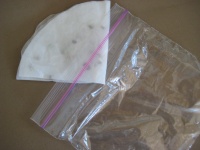 |
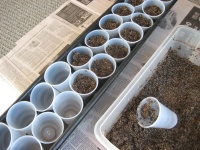 |
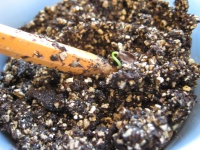 |
Growing Tropical Milkweed
Elementary School Science Projects
This is an excellent plant science project and provides the caterpillar food necessary for an elementary school science project of raising Monarch butterflies in the classroom in Spring. Or the students can bring home their plants at the end of the year, put them in their garden and raise monarchs at home. Tropical Milkweed is very easy to grow from seed and the monarchs love it!
- Order tropical milkweed seeds and start them in the classroom after Christmas – figure at least one, possibly two plants per caterpillar (so plan accordingly how many seeds to start)
- Follow coffee filter instructions for starting the tropical milkweed seeds
- Fill plastic cups (drainage hole in the bottom) with wet seed starting mix and plant sprouted seeds in cups
- Put in a sunny window and keep damp (not too wet)
- Once the seedling starts to grow, you can let “soil” start to dry a bit before watering (helps avoid mildew )
- Use ½ strength fertilizer in water every couple weeks or so
Spring Elementary School Science Project
Rearing Monarch Butterfly
Using the Tropical Milkweed that you grew in the plant science project above to replace the common milkweed, follow the step by step instructions for the Fall Elementary School Science Project. You will need at least one 4 month plant (maybe two) per caterpillar.
Below are tropical milkweed plants I had been growing for 2 months....the left plants were started from tropical milkweed cuttings (so they actually are 3 1/2 months along) and the right plants were started from seed. As you can see, the plants started from seed catch up quickly in size to the cuttings. You would probably need 2 to 3 of this size plant per caterpillar.

Make sure you have enough milkweed. In the Southern States you might be able to find common milkweed or other kinds of milkweed growing locally for this project.
Allow one month before school gets out to complete this elementary school science project and order the caterpillars accordingly.
If you do not have milkweed, consider purchasing a which uses artificial food. The monarch butterfly project is more interesting than the painted lady for an elementary school science project, but you need to have the milkweed for caterpillar food.
I hope these elementary school science projects get your students (and yourself!) excited about science!
Return to Home from Elementary School Science Projects



